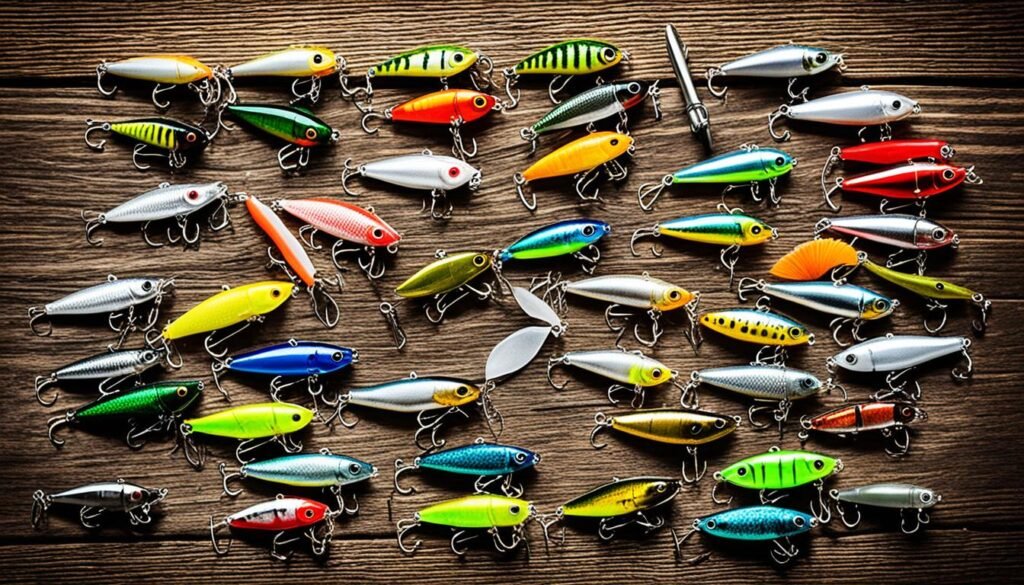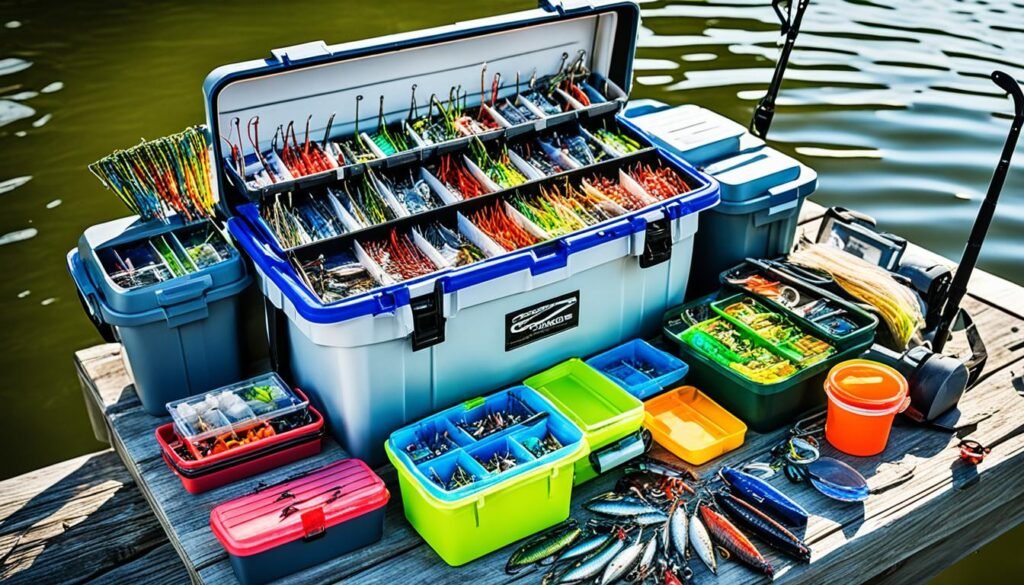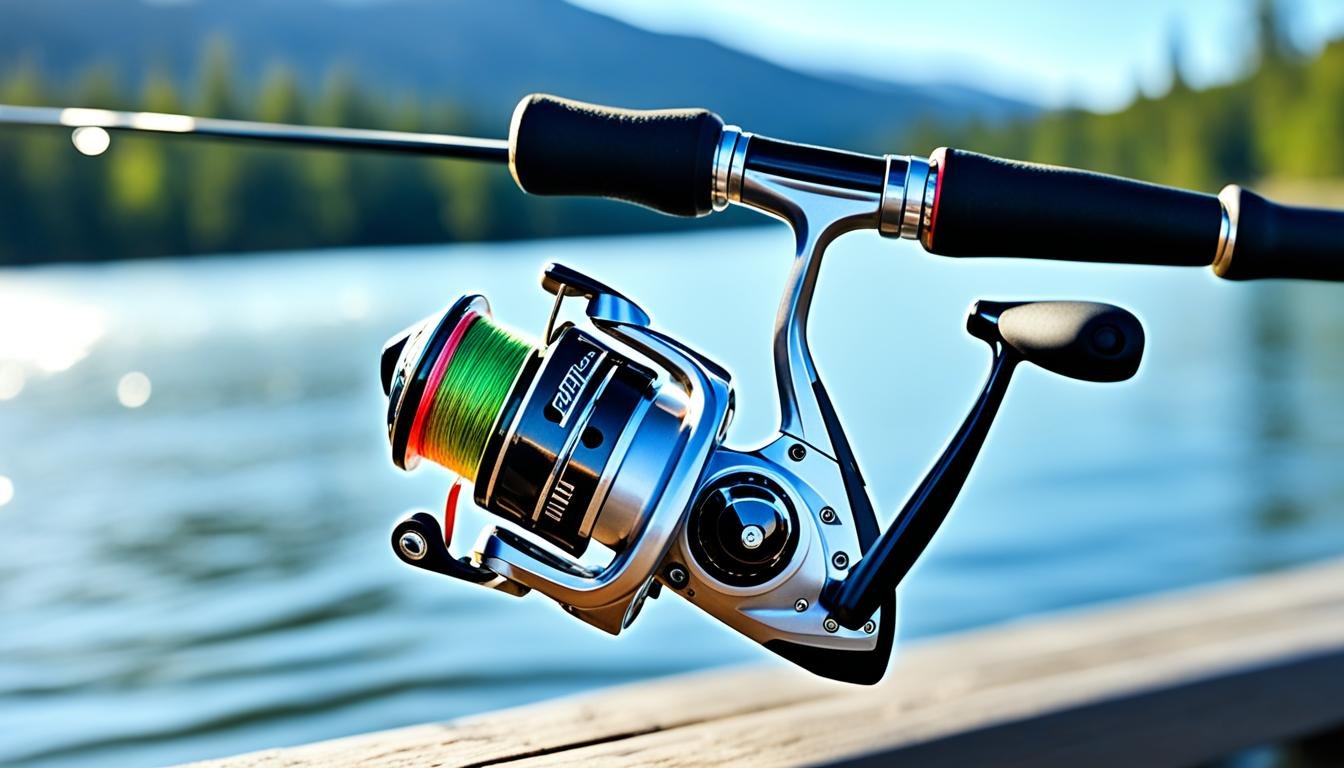Fishing is an art with many techniques and gear choices.
Beginners can feel overwhelmed by the variety of rods, reels, and lures available. Even experienced anglers started as novices once.
This guide will help you build your first fishing starter kit. We’ll cover everything from fishing rod and reel combos to essential fishing tackle.
We’ll also discuss entry-level fishing lines, fishing accessories for starters, and protective clothing. With the right affordable fishing equipment, you’ll be ready for your first angling adventure.
Key Takeaways about Choosing Fishing Gear for Beginners
- Fishing gear for beginners should include a 7-foot rod, spinning reel, and monofilament or fluorocarbon line.
- Understand rod power, action, and line/lure ratings to match your fishing needs.
- Invest in essential terminal tackle like hooks, sinkers, and swivels to complete your setup.
- Acquire necessary licenses and regulations for your fishing location.
- Equip yourself with practical accessories like a tackle box, line cutters, and protective clothing.
How to Choose Fishing Gear for Beginners
Picking the right fishing gear can be tricky for new anglers. But don’t worry! We’ll help you focus on the essentials. Let’s explore the must-haves for your angling adventures.
Fishing Rods and Reels
Start with a light to medium power spinning rod. Pair it with a 2000, 2500, or 3000 size spinning reel. This combo works great for trout, walleye, and bass.
Fishing Lines
Fishing lines are crucial for success. Choose monofilament or fluorocarbon lines for your first setup. They’re tough, affordable, and perfect for various fishing situations.
Fishing Lures
Get a mix of lures to start. Try spoons, spinners, hard baits, and soft plastic lures. Experiment with different shapes and sizes to find what works best.
Fishing Accessories
Don’t forget the essential fishing accessories. Pack pliers, tackle boxes, and protective gear. A good fishing hat and sunglasses are must-haves too.
Fishing Licenses and Regulations
Always get a valid fishing license before heading out. Learn the local rules to fish legally and responsibly. It’s part of being a good angler.
Focus on these key elements for your beginner’s fishing gear kit. Start with quality, affordable equipment. As you gain experience, you can expand your gear collection.
| Recommended Gear for Beginners | Specifications |
|---|---|
| Fishing Rod | 6-foot light-power St. Croix Premier or Ugly Stik Elite 5-foot, 6-inch |
| Fishing Reel | Pflueger President size 30, Shimano Sedona FI 1000 |
| Fishing Line | Monofilament, 4-8 lb test |
| Fishing Lures | Wordens Original Rooster Tail, Rapala Original Floater, Strike King’s Chrome Sexy Shad, Dardevle Spoons |
| Fishing Hooks | #6 and #4 baitholder hooks, #4 to #2 light-wire Aberdeen hooks, 1/0 to 3/0 circle hooks |
| Fishing Accessories | Pliers, tackle box, fishing hat, sunglasses |
With these tips, you’re set to build a great beginner-friendly fishing gear kit. Get ready for exciting and rewarding fishing trips!
Essential Fishing Rod and Reel Combos
Spinning Rods and Reels
Beginner anglers should start with a light spinning rod about 1.2 to 2 metres long. This setup works well for trout and small fish. It’s lightweight and handles smaller tackle easily.
Spinning reels store line on a spool with an adjustable friction device called a “drag”. The drag keeps tension on the line as it’s pulled off the spool. This helps prevent tangling and over-spinning.
Spincast Reel Considerations
Spincast rods have the reel on top, with upward-facing line guides. The line is stored under a cover and feeds from a small front hole.
Spincast reels are cheap and easy to cast. They’re great for kids or complete beginners. Spinning rods have the reel underneath, with downward-pointing line guides.
| Reel Type | Recommended Use | Pros | Cons |
|---|---|---|---|
| Spinning Reel | Trout, panfish, and other small game fish | Easy to use, smooth drag, and good for accuracy | May not handle large, powerful fish as well as baitcasting reels |
| Spincast Reel | Beginners, children, and fishing in tight spaces | Very affordable, simple to operate, and good for casting small lures | Limited line capacity and not as versatile as spinning reels |
Choosing the right fishing rod and reel combo for beginners involves several factors. Consider rod length, power, and action. Also, think about reel size and gear ratio.
The perfect combo can boost your fishing enjoyment and success. It’s worth taking time to find the right match.
“The right rod and reel combo can make all the difference for a beginner angler. It’s important to choose a setup that’s comfortable, balanced, and well-suited to the type of fishing you plan to do.”
Selecting the Right Fishing Line
Picking the right fishing line is key to angling success. There are three main types: monofilament, braided, and fluorocarbon. Each has unique features and benefits.
Understanding these differences will help you make a smart choice. Let’s explore each type to find the best fit for your needs.
Monofilament Lines
Monofilament has been a go-to for anglers for over 50 years. It’s clear or green and stretches up to 25 percent. This makes it a great all-purpose choice.
Monofilament is easy to use and forgiving. It’s perfect for fishing line for beginners. You can use it for trout, walleye, and other common fish.
Braided and Fluorocarbon Options
Braided lines are very strong and thin. But they’re easy to see in water. They’re often used as the main line in heavy tests.
Braided line doesn’t stretch, making it very sensitive. It’s popular for deep-water or dark-water fishing. Light tests can be tricky to handle.
Fluorocarbon lines are nearly invisible underwater. They’re often used for leaders. These lines are more sensitive than monofilament due to less stretch.
Anglers often use braided line with a fluorocarbon leader. This combo works well in clear water. It provides a stealthy presentation for flies and lures.
When choosing a fishing line, think about test (strength), visibility, and diameter. Match these to your rod, reel, and target fish.
Beginners should start with monofilament or fluorocarbon lines. A 6-12 pound test range works well for many species.
| Line Type | Pros | Cons |
|---|---|---|
| Monofilament |
|
|
| Braided |
|
|
| Fluorocarbon |
|
|
Know the strengths and weaknesses of each fishing line type. This knowledge helps you pick the right line for your fishing needs.
Choose between monofilament, braided, or fluorocarbon based on your target fish and fishing spot. Find the perfect balance of strength, visibility, and performance.
Bait, Lures, and Terminal Tackle

Choosing fishing gear can be tricky for new anglers. But knowing the basics helps make smart choices. Let’s look at the key parts of your fishing setup.
Bait options include natural items like worms and artificial ones. Entry-level fishing baits are great for attracting fish. Lures mimic prey movement and look.
Beginner’s fishing lures like spoons and spinners work well. They create water movement that fish notice. These lures can help new anglers catch more fish.
Terminal tackle includes hooks, leaders, and weights. Match hook size to your target fish. Terminal tackle for beginners might include bullet head weights and drop shot weights.
Different hook types suit various fishing styles. The Gamakatsu EWG Offset Worm Hook is one example. Another is the Gamakatsu Split Shot/Drop Shot Hook.
For the best essential fishing tackle, ask local experts. They know which gear works for specific fish and water conditions. Their advice can improve your fishing success.
| Bait Type | Examples |
|---|---|
| Soft Lures & Baits | Mostly Plastic, Soft Wood |
| Hard Lures & Baits | Wood, Plastic, Metal |
| Combos | Jigging Baits – Metal, Metal + Plastic, Metal + Feather |
| Spinners & Spoons | Metal, Metal + Plastic, Wood + Metal |
| Fly Baits | Fabric, Feather, Fur, Metal + One of the Above |
| Food Baits | Corn (Including for Carps), Meat (Chicken, Intestines, Other Meat Parts), Fish & Prawn Parts, Crabs, Muscle, Maize, Tiger Nuts, Potatoes & Tubers, Dead Worms, Bugs & Insects, Various Flours, Ground Grain or Seed/s Powder, Bread, Any other Food Items, Processed Meat and Vege Combos, Mixed / Modified Baits & Lures |
| Live Baits | Prawns, Minnows, Crabs, Mussels & Shellfish, Worms & Bugs, Insects, Other Baits & Lures |
Learning about beginner’s fishing lures, baits, and tackle improves your fishing setup. This knowledge helps you enjoy fishing more. It also boosts your chances of catching fish.
Fishing Hooks Made Simple
Fishing hooks are vital for your terminal tackle. The right size and type can greatly impact your fishing success. Choosing the correct hooks is key for catching fish of various sizes.
Hook Sizes and Types
Hook sizes are shown by numbers or “aught” (0) sizes. Larger numbers mean smaller hooks, while larger aught sizes are bigger. The hook size should match the fish’s mouth size you’re after.
A 6/0 hook suits a 5-inch plug for Chinook salmon. A 4/0 hook works well for hoochies and bait in summer and fall.
Hook shapes vary for different uses. Bait hooks, like the Gamakatsu Octopus, are for live or cut bait. Siwash hooks come in straight, offset, and wide gape styles.
Circle hooks reduce gut hooking and eye gouging. They’re popular for large game fish. Treble hooks on lures increase hook-up chances.
Barbless vs Barbed Hooks
Barbless hooks are easier to remove from a fish’s mouth. They’re good for catch-and-release fishing. Barbed hooks hold stronger, ideal for hard-fighting fish or strong currents.
Check local rules, as some waters ban barbed hooks. Match the hook to your lure or bait. Keep hooks sharp for best results.
“Choosing the right fishing hooks can make all the difference in your angling success. Pay close attention to size, shape, and barb characteristics to ensure you’re using the most effective terminal tackle for your target species and fishing conditions.”
Essential Fishing Accessories

Fishing requires more than just a rod and reel. Other accessories can boost your experience and keep gear organized. These items can make your fishing trips more comfortable and successful.
Tackle Boxes and Storage
A tackle box is crucial for new anglers. It organizes hooks, lures, and other small items. The Plano Guide Series Tackle System offers ample storage with customizable compartments.
Rod Cases and Protective Gear
Rod cases shield your fishing rod during transport. They keep your equipment in top shape for future trips. Breathable shirts and waterproof pants protect you from the elements.
Pliers help remove hooks safely. A landing net secures your catch. A quality knife is useful for cutting line or bait.
“Proper gear and accessories can make all the difference in your fishing experience, especially for a beginner. Investing in a few key items can help ensure a successful and comfortable day on the water.”
The right accessories can greatly improve your fishing trips. A well-equipped kit prepares you for challenges and enhances enjoyment. Invest in these items to make the most of your outdoor adventures.
Regulations and Licensing
In Canada, you need a fishing licence to fish legally. Costs and duration vary based on age, residency, and fishing type. Always carry your valid licence while fishing.
Familiarize yourself with fishing regulations in your area. These include catch limits, prohibited methods, and protected species. Following rules ensures responsible fishing and legal compliance.
Understanding regulations helps protect fish populations. It contributes to sustainable fishing and healthy ecosystems. Your efforts make a difference in preserving the sport.
“Responsible conservation practices include not keeping more fish than can be eaten, proper catch and release techniques, packing out what is brought in, and knowing state fishing regulations.”
Ontario requires a fishing licence for most anglers. Exemptions exist for certain age groups and communities. An Outdoors Card, valid for three years, costs under $10.
Ontario offers four opportunities to fish without a licence. These include Family Fishing Weekend in February and Ontario Family Fishing Week in June.
In Quebec, annual fishing licences cost $24.12. They’re valid from April 1 to March 31. Various licence lengths and categories are available.
Learn your area’s fishing licence requirements and regulations. This ensures a safe, legal, and responsible experience. Your knowledge helps sustain the sport for future generations.
Conclusion
Choosing the right fishing gear as a beginner can be overwhelming. This guide provides essential information for a successful first angling adventure. We’ve covered everything from rod and reel combos to fishing lines, lures, and terminal tackle.
We’ve also highlighted protective gear, storage solutions, and fishing regulations. With the right equipment and knowledge, you can focus on the thrill of catching your first fish. This guide prepares you for a rewarding fishing journey.
The right fishing equipment is crucial for a positive experience. Take time to consider your needs and preferences carefully. With proper gear, you’ll be ready to create lasting memories on the water.
This beginner’s fishing guide equips you with knowledge about how to choose fishing gear for beginners. It sets you up for an enjoyable and successful fishing adventure.
For an overview about Fishing for Beginners in Canada, please check this guide.
FAQ about Choosing Fishing Gear for Beginners
What basic gear do I need for fishing?
For beginners, the essential fishing gear includes:
- Fishing rod and reel combo (preferably a spinning rod and reel)
- Fishing line (10 lb test monofilament is recommended for beginners)
- Hooks (variety of sizes, including J-hooks)
- Bait (live bait like worms or artificial lures)
- Bobbers
- Sinkers
- Tackle box
- Pliers and line cutter
- Fishing license
What type of fishing is best for beginners?
The best types of fishing for beginners are:
- Float (bobber) fishing – It’s visual and helps teach when to set the hook
- Spin casting – Easy to use and great for catching panfish
- Shore fishing in lakes or rivers – Accessible and doesn’t require a boat
- Fishing for panfish like sunfish or perch – These fish are abundant and easier to catch
How to choose a fishing rod for beginners?
For beginners, it’s recommended to:
- Choose a spinning rod and reel combo
- Look for a medium action rod rated for 8-20 lb line
- Select a rod length between 6-7 feet for versatility
- Consider a combo like the Ugly Stik GX2, which is durable and reasonably priced
What is the best fishing line for beginners?
For beginners, monofilament line is recommended:
- It’s versatile, buoyant, and has some stretch
- 10 lb test is a good all-around choice
- Berkley Trilene XL Smooth Casting clear monofilament is suggested as a good starting option
Is braid better than mono?
While braided line has advantages like strength and thinness, monofilament is generally better for beginners because:
- It’s easier to handle and tie knots with
- It’s more forgiving when fighting fish due to its stretch
- It’s less visible in the water
Should I use monofilament or fluorocarbon?
For beginners, monofilament is recommended over fluorocarbon because:
- It’s easier to handle and tie knots with
- It’s more versatile for different fishing techniques
- It’s less expensive
Fluorocarbon has advantages like being nearly invisible underwater and more abrasion-resistant, but it’s generally more suitable for more experienced anglers or specific fishing situations.
What are the essential components of a beginner’s fishing kit?
A beginner’s fishing kit needs a rod and reel combo, fishing line, and bait or lures. It also requires terminal tackle, a tackle box, protective gear, and tools.
What type of fishing rod and reel is recommended for beginners?
Beginners should use a light to medium power spinning rod. Pair it with a 2000, 2500 or 3000 size spinning reel. This setup works well for trout, walleye, and bass.
What type of fishing line should a beginner use?
Beginners should start with monofilament or fluorocarbon fishing lines. Choose lines in the 6-12 pound test range. These lines are forgiving and suit many common fish species.
What are some good lure options for a beginner?
Spoons are great lures for beginners. They wobble and dart in the water. Spinners are also effective, producing vibrations and flash. Natural baits like worms and roe work well too.
What kind of hooks should a beginner use?
Match the hook size and type to your target fish. Check local rules about hook types. Some areas restrict the use of barbed hooks.
What other essential accessories should a beginner have?
Beginners need a tackle box to organize gear. A rod case helps with transport. Pliers, knives, and a landing net are crucial.
Protective clothing is important too. Wear breathable, quick-drying shirts and waterproof pants or boots.
Do I need a fishing licence in Canada?
Yes, fishing in Canada usually requires a licence. The cost and duration vary based on age, residency, and fishing type. Always carry your valid fishing licence when angling.
Source Links
- https://fishingbooker.com/blog/fishing-gear-for-beginners/
- https://www.gofishbc.com/learn/fishing-tips/lake-fishing/beginners-guide-to-fishing-rods-tackle/
- https://www.sail.ca/blog/what-to-put-in-your-first-fishing-kit-the-essentials-for-beginners/
- https://www.coastalfishing.com/blogs/saltwater-fishing-101/best-saltwater-fishing-gear-and-equipment-for-beginners
- https://www.pecherpascomplique.com/en/choosing-fishing-rod-reel/
- https://fishingbooker.com/blog/beginner-fishing-setup/
- https://www.repspark.com/blog/best-fishing-reel-combo-for-beginners
- https://www.gonexsport.com/blogs/gift-guides/how-to-pick-the-best-rod-and-reel-for-beginners
- https://www.outdoorlife.com/how-to-pick-right-kind-fishing-line/
- https://www.takemefishing.org/how-to-fish/fishing-gear-and-tackle/how-to-choose-fishing-line/
- https://www.wired2fish.com/tackle-tips/how-to-choose-the-best-fishing-line-for-spinning-reels
- https://www.wired2fish.com/fishing-tips/introduction-to-fly-fishing-gear-basics
- https://fishermanshub.com/blogs/beginners-guide/a-beginners-guide-to-fishing-tackle-list-of-different-fishing-tackle-varieties
- https://krakenbass.com/essential-bass-fishing-tackle/
- https://islandfishermanmagazine.com/choosing-the-right-fishing-hook/
- https://www.wired2fish.com/fishing-tips/a-guide-to-fishing-hooks-use-and-type-explained
- https://www.flyfisherman.com/editorial/Making-Sense-of-Hooks/383617
- https://fishbrain.com/blog/fishing-gear/fishing-starter-kit-essential-gear-for-beginners
- https://gofishbc.com/learn/fishing-tips/lake-fishing/beginners-guide-to-fishing-rods-tackle/
- https://deepersonar.com/blogs/us/top-7-fishing-gear-essentials-first-time-anglers
- https://bushlife.ca/fishing/
- https://www.takemefishing.org/how-to-fish/fishing-resources/everything-you-need-to-start-fishing/


